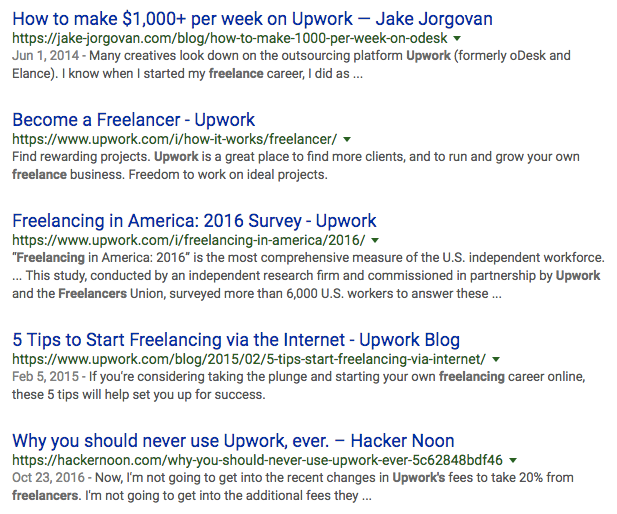How to Outrank Bad Reviews in Organic Search
Someone has written a scathing review of your brand or product, and it’s outranking your site in organic search. It might be a Glassdoor review from a disgruntled former employee, or a product/service review from a competitor posing as a dissatisfied former client. Either way, it’s a PR nightmare, and it doesn’t exactly instill company leadership with confidence in SEO.
Before you react, it’s important to have a plan in place. Take the right approach and you can outrank negative reviews. Take the wrong approach and you could damage the company’s reputation even further.
While a high-ranking negative review can be disconcerting, it is possible to outrank negative reviews and restore brand reputation in search results.
1. Confirm the Ranking Order
If the negative review is a page you’ve viewed before, it’s possible that Google is ranking the review higher just for you because it believes that’s what you’re looking for. Conduct a depersonalized search to confirm that the results aren’t just a personalization anomaly.

Beyond depersonalization, conduct the search on different computers to see if the same results appear on both a work device and a personal device. You can also ask trusted friends and/or coworkers to conduct the search on their computers to help validate your findings. If the negative review ranks higher for several people, from several IP addresses, it’s probably ranking higher for your audience.
2. Conduct User Intent Research
After confirming that the negative review truly has a higher ranking, it’s time to find out why. In all likelihood, it’s because Google believes the negative review does a better job of satisfying user intent for that query. It’s possible that it’s earning a higher ranking because your content doesn’t provide the information users are looking for when searching for that term.
Take the keyword “freelancing on Upwork” as an example. Upwork is a job board that’s focused on connecting freelancers with potential clients. A marketer at Upwork may assume that people searching for “freelancing on Upwork” have purchase intent—that they’re asking the question, “How do I sign up as a freelancer on Upwork?” But the search results paint a different picture:

While Upwork’s signup page is in position two, the other five of the top six results—including a negative review—have inform-intent. They’re answering questions like, “Should I sign up for Upwork?” and, “How do I make more money on Upwork?” This shows that “freelancing on Upwork” is primarily a learn-intent keyword.
Review the page one results for the query that produces your negative review. If your targeted content doesn’t satisfy user intent, but the negative review does, Google will prioritize the review.
Validate these findings by reviewing engagement metrics like bounce rate and time on page. If the content has a high bounce rate and a low time on page, users are likely leaving the page and returning to view other search results because the content didn’t provide the necessary information.
3. Investigate RankBrain Priorities for Relevant Keywords
After isolating keywords that populate negative reviews and determining user intent, go one step deeper and try to figure out what RankBrain is prioritizing for those keywords.
RankBrain is Google’s machine-learning algorithm that helps set rankings by determining what factors lead to increased engagement and click-through rates for individual keywords. It considers a variety of factors:
- Reviews and ratings. If a negative review is displaying high in search results, it’s likely that users are looking for reviews and/or testimonials. You would also likely see Facebook pages with the star reviews displayed, third party comparison content, etc.
- Depth of content. Are the results long and detailed guides, or are they primarily lists that highlight snippets of information? If most results are in-depth, content comprehensiveness may be a ranking factor.
- Timeliness. In some cases, RankBrain prioritizes content freshness. If most other results were published recently, content freshness may be a ranking factor.
- Format. If the negative review and other top results use video, infographics, or tables, use of visual media could be a positive ranking factor.
- Links. Use a tool like the Moz Toolbar to see how many pages and domains are linking to each page one organic result. If the numbers are inconsistent, links might not be a factor, but if the top pages all have a lot of links, RankBrain might be prioritizing them.
- Keywords. If the same one or two words is present in many of the titles and URLs, RankBrain might be prioritizing keywords for that query.
Take note of any consistencies in top results, and then use RankBrain preference information and user intent insights to optimize content to rank above the negative review.
4. Optimize Content for User Intent and RankBrain Preferences
Using intent and RankBrain preference insights, update content to cater to what users— what Google—are looking for:
- Create resources for learn intent keywords. If the primary user intent is learn, you need a resource, not a sales page. Answer questions, define terms, provide links to more resources. Check the related questions and searches for inspiration.
- Create sales pages for purchase intent keywords. If the primary intent is purchase, create a sales page that addresses value and uses clear CTAs. Include testimonials from clients, and link to case studies and price sheets.
- Cater to RankBrain. If timeliness is a priority, include a note at the top about the date the page was most recently updated. If media is important, make sure to include unique images and video.
- Stand out from the competition. When intent and RankBrain preferences are addressed, consider how the content can be even better, to stand out. Some features may have been missing from SERPs because they haven’t been tried yet. Just because there was no video on page one, for example, doesn’t mean RankBrain doesn’t like video: it probably means the competition hasn’t tried it yet.
If a negative review on Glassdoor is outranking your careers page, for example, consider building and including some onboarding marketing materials. Create a promotional video, ask employees to provide written testimonials, and dedicate more space on the page to discussing what it’s like to work for your company.
5. Expand Efforts on Social Channels
If the problematic review displays for general searches of your brand name, it’s possible to earn more page-one rankings for properties by expanding efforts on social media. For example, a depersonalized search for Profound Strategy results in our website, followed by our profiles on Facebook, Twitter, and LinkedIn.

Expand efforts to additional social channels—and include markup that specifies social profiles for Google—to claim more SERP real estate with official properties. Ideally, this will push negative reviews below the fold—or even off of page one.
If You Can’t Outrank the Review, Adopt Public Relations Best Practices
Optimizing content for user intent and RankBrain preferences works well if the negative review is a blog post, but if the review is on a major review site like Glassdoor, G2 Crowd, or Google, it may be difficult to outrank these sites. In these cases, it may be best to turn to some reputation management best practices from the PR department.
Request Additional Reviews
The best way to water down a scathing review is by surrounding it with positive reviews. Start asking happy clients and coworkers to write reviews on the offending site.
- If the problematic page is Glassdoor, send a request to current employees and ask if they will provide honest reviews of their experience at the company on Glassdoor.
- If the problematic page is Google or G2 Crowd, ask customers to provide reviews of your company/products/services on that site.
In either case, the ethics of offering an incentive for posting a review is questionable, so the best approach is to ask nicely and hope people respond. Add the request to your email signature, include it in the footer of marketing emails, send internal staff an email with the request, or post the request to company social media channels.
If customers and employees care about your brand, they should be happy to take a few minutes to provide some alternative opinions that help balance out the negative review.
Respond to Negative Reviews
Most review sites allow business owners to respond to reviews. Responding may get the dissatisfied customer to give you a second chance, and it shows prospects that you strive to provide exceptional customer service.
A simple response is often sufficient:
We’re sorry your experience was unsatisfactory, and we’d love to discuss these issues with you in more detail. Please give us a call so we can learn more about why we failed to meet your expectations, and discuss if there is any way to get you to give us another chance to impress you.
But coming up with something more creative is ideal. Chef John Howie responds to reviews of his restaurant—both positive and negative—by video:
This method of responding is highly personal. It’s not an intern or robot responding to the review by copying and pasting a prewritten response. It’s a business owner showing that he cares enough to read the reviews his customers write, and he wants to ensure customers are fully satisfied with their experiences.
4 Things NOT to Do in Response to Negative Reviews
Counteracting negative reviews with SEO, improved content, and reputation management are excellent ways to mitigate the effects of a negative review—if they’re executed thoughtfully. If they’re executed poorly, they can damage the company’s reputation even further. When reacting to negative reviews, steer clear of these faux pas:
- Don’t purchase a variety of domains and fill them with content designed to push the negative review off of the page. It’s highly unlikely that the content on new sites will rank on page one, and the strategy falls definitively into black-hat SEO territory. Instead, spend that time improving the quality of existing content for higher rankings, and expand social media efforts.
- Don’t write fake reviews or encourage employees/customers to write fake reviews. It’s deceptive, and it’s usually obvious. If reviews sound too good to be true, prospects may question the legitimacy of the reviews and, in turn, the quality of your business.
- Don’t write accusatory responses to negative reviews. Even if you are 100% certain that a competitor is writing the negative reviews, responding with accusations is tacky and comes across as childish. Take the opportunity to wow prospective customers with a creative and caring response, turning the tables on vindictive competitors.
- Don’t bother with negative link building. Another scheme that black hat SEOs recommend is negative link building—the process of getting low-quality sites to add hundreds of links to a competitor’s page in order to get a ranking penalty applied. Beyond the ethical implications, this no longer works thanks to Google’s Penguin 4.0 update.
When an outranking negative review is first discovered, it can be easy to panic and respond poorly. Instead, take time to evaluate the situation. Form a thoughtful approach to handle the review in a positive way that restores your brand’s reputation.
How to Outrank Negative Reviews
Ideally, your company will never have this problem, but it’s hard to please everyone and some people, unfortunately, can get a little nasty online. The best approach to outranking negative reviews is to focus on optimizing content for user intent and RankBrain’s priorities. If a negative review is appearing above your content, it’s likely because Google believes it provides a better answer to the question behind the query.
Optimize your page for the appropriate user intent by creating more compelling and comprehensive content, and you may be able to take back the top position with content that reflects your brand and products positively.
What's Next?
Profound Strategy is on a mission to help growth-minded marketers turn SEO back into a source of predictable, reliable, scalable business results.
Start winning in organic search and turn SEO into your most efficient marketing channel. Subscribe to updates and join the 6,000+ marketing executives and founders that are changing the way they do SEO:
And dig deeper with some of our best content, such as The CMO’s Guide to Modern SEO, Technical SEO: A Decision Maker’s Guide, and A Modern Framework for SEO Work that Matters.





